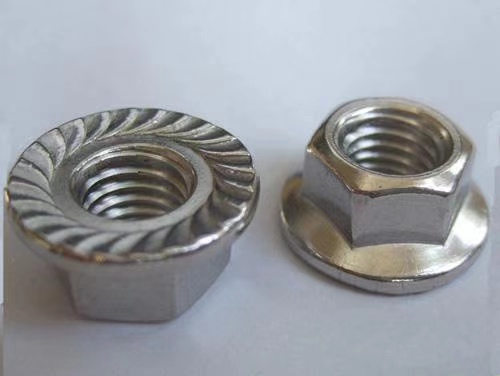1. Definition and Characteristics of Flange Nut: A flange nut is a type of nut with a hexagonal flange face, also known as a washer nut, serrated nut, hexagonal flange face nut, flange nut, etc. One end of it has a wide flange, which is equivalent to an integrated washer. This structure can distribute the pressure of the nut to the fixed component, reducing the possibility of component damage and making it less likely to loosen due to uneven fastening surfaces. Compared with ordinary hex nuts, flange nuts have anti slip teeth at the bottom, which increases the surface area of contact with the workpiece. Compared with the combination of ordinary nuts and washers, they are more sturdy and have greater tensile strength.
2. “Specification and Application Fields of Flange Nuts”: Generally, the specifications of flange nuts are generally below M20, because most flange nuts are used on pipelines and flanges, constrained by workpieces, and have fewer specifications compared to ordinary nuts. Some flange nuts above M20 are mostly flat flanges, which means there are no teeth on the flange surface. These nuts are mostly used in some special equipment and places, and the general sales manufacturers do not have stock. Flange nuts are mostly used in pipeline connections or workpieces that require an increased nut contact surface, such as in mechanical manufacturing, automotive manufacturing, construction industries, etc.
3. “Production process and surface treatment of flange nuts”: The production process of flange nuts includes cold heading, hot heading, etc., and strict control of dimensional accuracy and quality is required during the production process. Its surface treatment is generally divided into two types: colored zinc plating and white zinc plating, and is mostly cold electroplated zinc plating to improve the corrosion resistance and aesthetics of the nut.
4. Market Development Prospects of Flange Nuts: With the continuous development of various industries, the demand for flange nuts is also increasing. Especially in fields such as power, transportation, and communication, the application of flange nuts is becoming increasingly widespread. According to relevant research, the global revenue from flange nuts was approximately $87.95 million in 2020, and is expected to reach $99.23 million by 2026. The compound annual growth rate from 2021 to 2026 is 3.1%.
5. Advantages and disadvantages of flange nuts: The advantages include good fastening performance, resistance to loosening, reduced component damage, and easy installation; The disadvantage is that hot-dip galvanizing has some defects, such as difficulty in threading after plating, high operating temperature of hot-dip galvanizing will reduce the mechanical strength of high-strength flange nuts, poor working environment and serious pollution, etc.
6. “Selection and Precautions for the Use of Flange Nuts”: When selecting, it is necessary to choose flange nuts with appropriate specifications, materials, and surface treatments according to specific usage scenarios and requirements. When using, pay attention to the correct installation method to avoid loosening or damaging the nut due to improper installation. At the same time, for occasions with special requirements such as high temperature, high pressure, corrosive environment, etc., special materials or flange nuts that have undergone special treatment need to be selected.
Post time: Oct-16-2024

